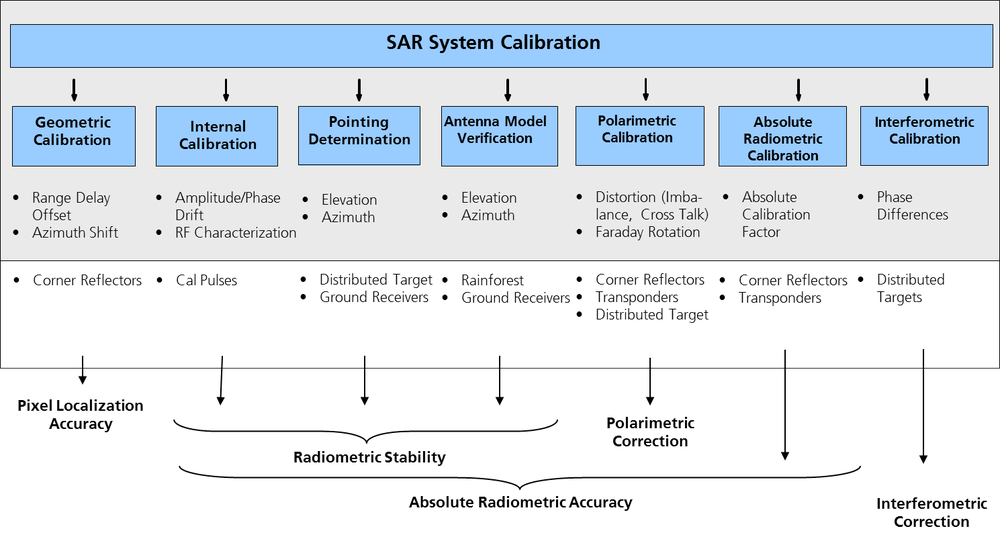Calibration Procedures
Taking all aspects mentioned before into account, the realization of the calibration concept is shown in Diagramm below. This strategy is based on innovative procedures/methods developed by DLR and by the experience gained from different SAR missions like TerraSAR-X, TanDEM-X, as well as Sentinel-1A and Sentinel-1B.

The geometric calibration procedure analyses the annotation of the source packets and the range delay w.r.t. different error contribution like systematic azimuth shifts and instrument delays. This is performed against reference targets with well-known position and internal delay.
Monitoring of the instrument and consequently compensating for drift effects is achieved by internal calibration. This calibration procedure has to be executed not only during the CP but also during the whole lifetime of the instrument. Based on an accurate internal calibration facility and enabling the so called PN-gating method (also known as PCC technique), calibration pulses are activated in such a way that critical parts, i.e. active components of the signal chain are covered by these pulses for both on receive and on transmit. Thus, drift effects can be compensated for and individual Transmit/Receiver Modules (TRMs) can be characterized in-flight – ensuring at the end the radiometric stability of the SAR instrument over lifetime.
The alignment of a SAR system is based on the determination of the actual pointing of the antenna beams in order to ensure a correct illumination of the swath in elevation and azimuth direction. Pointing determination is performed e.g. using ground receivers or other suitable targets like the Amazon rainforest.
The verification of the antenna model is based on a set of suitable beams which are really measured in flight using likewise ground receivers, ground transmitters or other proper distributed targets like the Amazon rainforest. After successful verification of the antenna model, thousands of precise reference patterns are available for the radiometric correction performed during SAR data processing.
Polarimetric calibration is based on inter-channel characterization, i.e. the determination of the channel imbalance in amplitude and in phase between the respective channels and the cross talk. By means of internal calibration and by external measurements against suitable reference targets the distortion parameters through the instrument are derived, whereby for lower frequency bands also the Faraday rotation has to be considered.
After correcting the antenna pointing of the SAR system, the drift compensation of the instrument, the radiometric correction of the antenna patterns and polarimetric calibration, all SAR data products are radiometrically calibrated relative to each other. Finally, by measuring the whole SAR system against reference targets the image information can be transformed into geophysical units (radar cross section (RCS) or backscattering coefficients for point or distributed targets respectively) and an absolute radiometric calibration of all SAR data products is achieved.
Except for internal calibration all other calibration procedures are often summarized as external calibration. For this purpose proper calibration targets have to be developed, a suitable calibration site (Read More) has to be established and deployed and the commissioning phase has to be planed.
The essential task of interferometric calibration is to estimate the interferometric phase, i.e. the baseline between the satellites, the relative phase drift between the instruments and the differential propagation path has to be known with high accuracy.
However, in order to realize this calibration concept in an efficient way, our antenna model approach has been developed and established.
